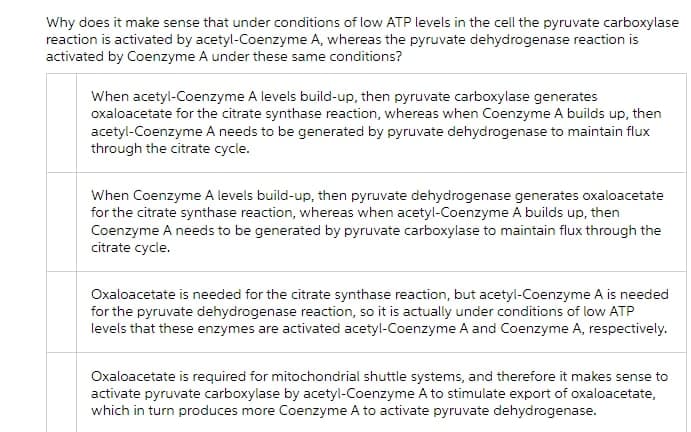Why does it make sense that under conditions of low ATP levels in the cell the pyruvate carboxylase reaction is activated by acetyl-Coenzyme A, whereas the pyruvate dehydrogenase reaction is activated by Coenzyme A under these same conditions? When acetyl-Coenzyme A levels build-up, then pyruvate carboxylase generates oxaloacetate for the citrate synthase reaction, whereas when Coenzyme A builds up, then acetyl-Coenzyme A needs to be generated by pyruvate dehydrogenase to maintain flux through the citrate cycle. When Coenzyme A levels build-up, then pyruvate dehydrogenase generates oxaloacetate for the citrate synthase reaction, whereas when acetyl-Coenzyme A builds up, then Coenzyme A needs to be generated by pyruvate carboxylase to maintain flux through the citrate cycle. Oxaloacetate is needed for the citrate synthase reaction, but acetyl-Coenzyme A is needed for the pyruvate dehydrogenase reaction, so it is actually under conditions of low ATP levels that these enzymes are activated acetyl-Coenzyme A and Coenzyme A, respectively. Oxaloacetate is required for mitochondrial shuttle systems, and therefore it makes sense to activate pyruvate carboxylase by acetyl-Coenzyme A to stimulate export of oxaloacetate, which in turn produces more Coenzyme A to activate pyruvate dehydrogenase.
Why does it make sense that under conditions of low ATP levels in the cell the pyruvate carboxylase reaction is activated by acetyl-Coenzyme A, whereas the pyruvate dehydrogenase reaction is activated by Coenzyme A under these same conditions? When acetyl-Coenzyme A levels build-up, then pyruvate carboxylase generates oxaloacetate for the citrate synthase reaction, whereas when Coenzyme A builds up, then acetyl-Coenzyme A needs to be generated by pyruvate dehydrogenase to maintain flux through the citrate cycle. When Coenzyme A levels build-up, then pyruvate dehydrogenase generates oxaloacetate for the citrate synthase reaction, whereas when acetyl-Coenzyme A builds up, then Coenzyme A needs to be generated by pyruvate carboxylase to maintain flux through the citrate cycle. Oxaloacetate is needed for the citrate synthase reaction, but acetyl-Coenzyme A is needed for the pyruvate dehydrogenase reaction, so it is actually under conditions of low ATP levels that these enzymes are activated acetyl-Coenzyme A and Coenzyme A, respectively. Oxaloacetate is required for mitochondrial shuttle systems, and therefore it makes sense to activate pyruvate carboxylase by acetyl-Coenzyme A to stimulate export of oxaloacetate, which in turn produces more Coenzyme A to activate pyruvate dehydrogenase.
Biochemistry
6th Edition
ISBN:9781305577206
Author:Reginald H. Garrett, Charles M. Grisham
Publisher:Reginald H. Garrett, Charles M. Grisham
Chapter19: The Tricarboxylic Acid Cycle
Section: Chapter Questions
Problem 22P: Study Figure 19.18 and decide which of the following statements is false. Pyruvate dehydrogenase is...
Related questions
Question
please explain than solve

Transcribed Image Text:Why does it make sense that under conditions of low ATP levels in the cell the pyruvate carboxylase
reaction is activated by acetyl-Coenzyme A, whereas the pyruvate dehydrogenase reaction is
activated by Coenzyme A under these same conditions?
When acetyl-Coenzyme A levels build-up, then pyruvate carboxylase generates
oxaloacetate for the citrate synthase reaction, whereas when Coenzyme A builds up, then
acetyl-Coenzyme A needs to be generated by pyruvate dehydrogenase to maintain flux
through the citrate cycle.
When Coenzyme A levels build-up, then pyruvate dehydrogenase generates oxaloacetate
for the citrate synthase reaction, whereas when acetyl-Coenzyme A builds up, then
Coenzyme A needs to be generated by pyruvate carboxylase to maintain flux through the
citrate cycle.
Oxaloacetate is needed for the citrate synthase reaction, but acetyl-Coenzyme A is needed
for the pyruvate dehydrogenase reaction, so it is actually under conditions of low ATP
levels that these enzymes are activated acetyl-Coenzyme A and Coenzyme A, respectively.
Oxaloacetate is required for mitochondrial shuttle systems, and therefore it makes sense to
activate pyruvate carboxylase by acetyl-Coenzyme A to stimulate export of oxaloacetate,
which in turn produces more Coenzyme A to activate pyruvate dehydrogenase.
Expert Solution
This question has been solved!
Explore an expertly crafted, step-by-step solution for a thorough understanding of key concepts.
This is a popular solution!
Trending now
This is a popular solution!
Step by step
Solved in 2 steps

Recommended textbooks for you

Biochemistry
Biochemistry
ISBN:
9781305577206
Author:
Reginald H. Garrett, Charles M. Grisham
Publisher:
Cengage Learning

Biochemistry
Biochemistry
ISBN:
9781305577206
Author:
Reginald H. Garrett, Charles M. Grisham
Publisher:
Cengage Learning